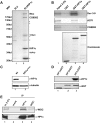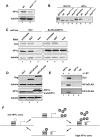Drosophila HP1c is regulated by an auto-regulatory feedback loop through its binding partner Woc
- PMID: 19352434
- PMCID: PMC2662408
- DOI: 10.1371/journal.pone.0005089
Drosophila HP1c is regulated by an auto-regulatory feedback loop through its binding partner Woc
Abstract
HP1 is a major component of chromatin and regulates gene expression through its binding to methylated histone H3. Most eukaryotes express at least three isoforms of HP1 with similar domain architecture. However, despite the common specificity for methylated histone H3, the three HP1 isoforms bind to different regions of the genome. Most of the studies so far focused on the HP1a isoform and its role in transcriptional regulation. As HP1a requires additional factors to bind methylated chromatin in vitro, we wondered whether another isoform might also require additional targeting factors. Indeed, we found that HP1c interacts with the DNA binding factors Woc and Row and requires Woc to become targeted to chromatin in vivo. Moreover, we show that the interaction between HP1c and Woc constitutes a transcriptional feedback loop that operates to balance the concentration of HP1c within the cell. This regulation may prevent HP1c from binding to methylated heterochromatin.
Conflict of interest statement
Figures



References
-
- Nielsen PR, Nietlispach D, Mott HR, Callaghan J, Bannister A, et al. Structure of the HP1 chromodomain bound to histone H3 methylated at lysine 9. Nature. 2002;416:103–107. - PubMed
-
- Bannister AJ, Zegerman P, Partridge JF, Miska EA, Thomas JO, et al. Selective recognition of methylated lysine 9 on histone H3 by the HP1 chromo domain. Nature. 2001;410:120–124. - PubMed
Publication types
MeSH terms
Substances
LinkOut - more resources
Full Text Sources
Molecular Biology Databases
Research Materials

